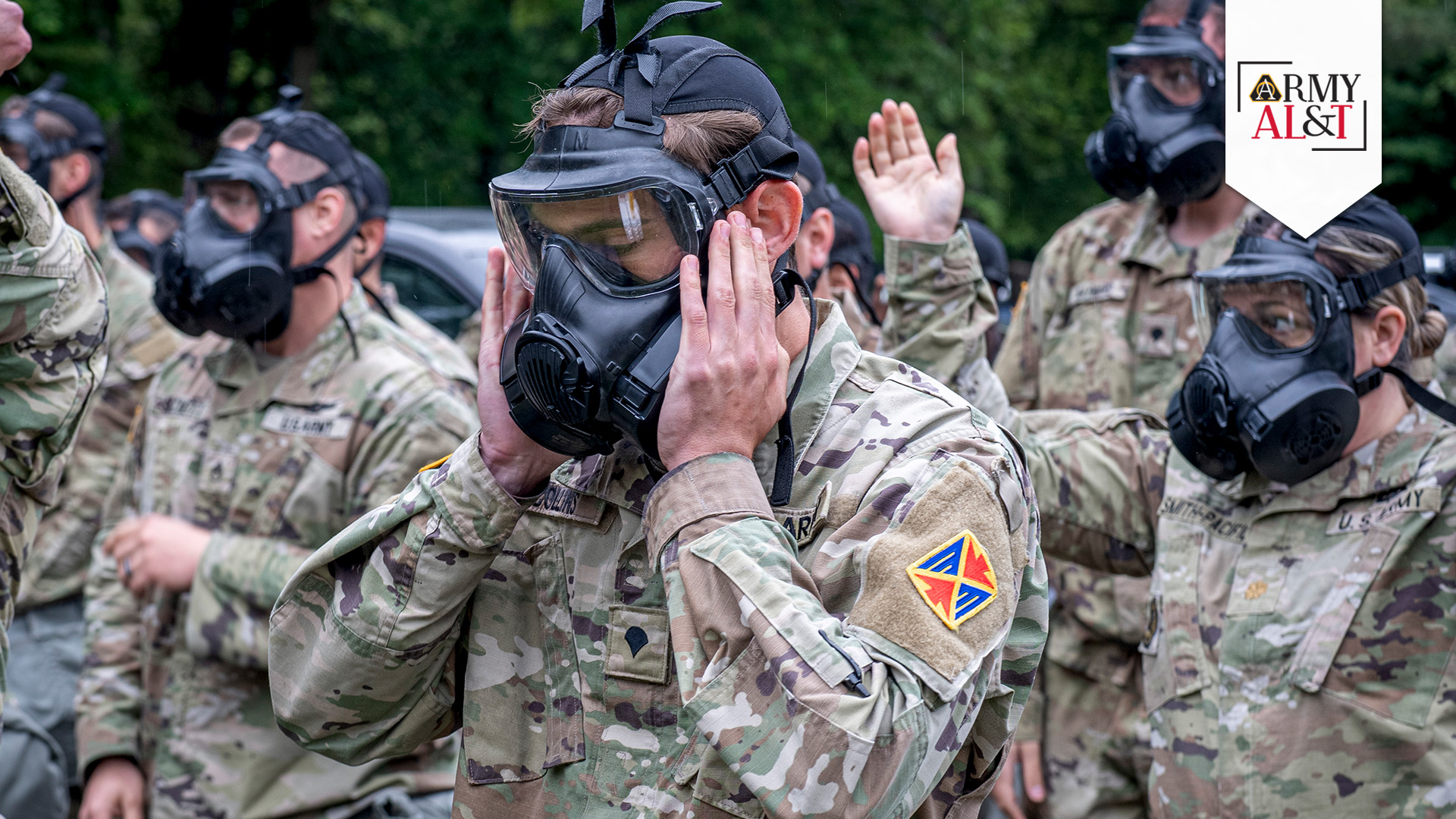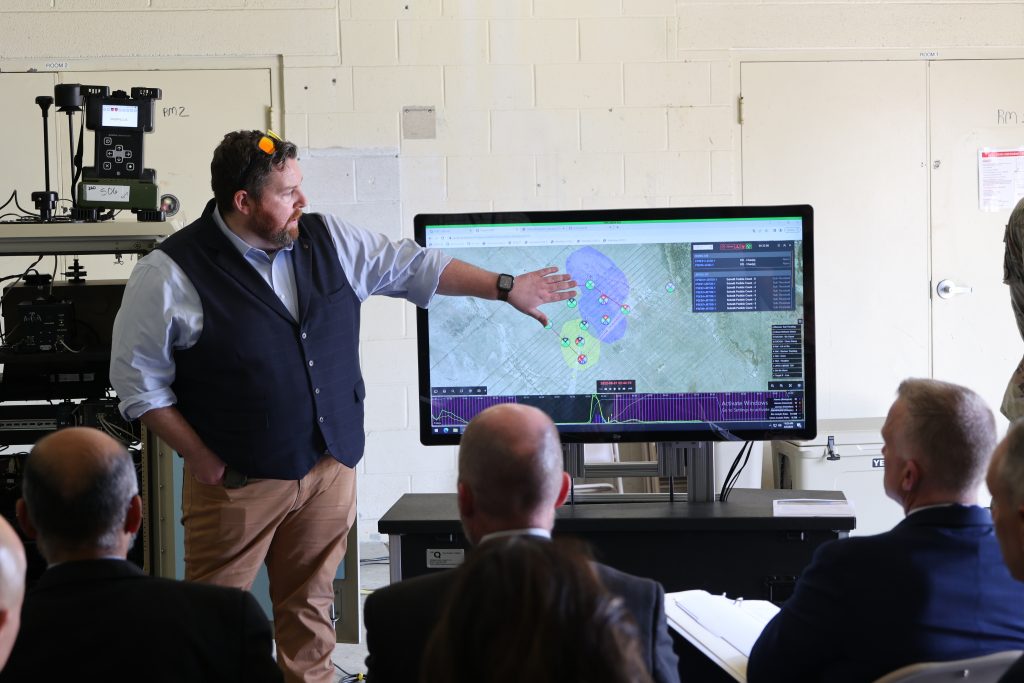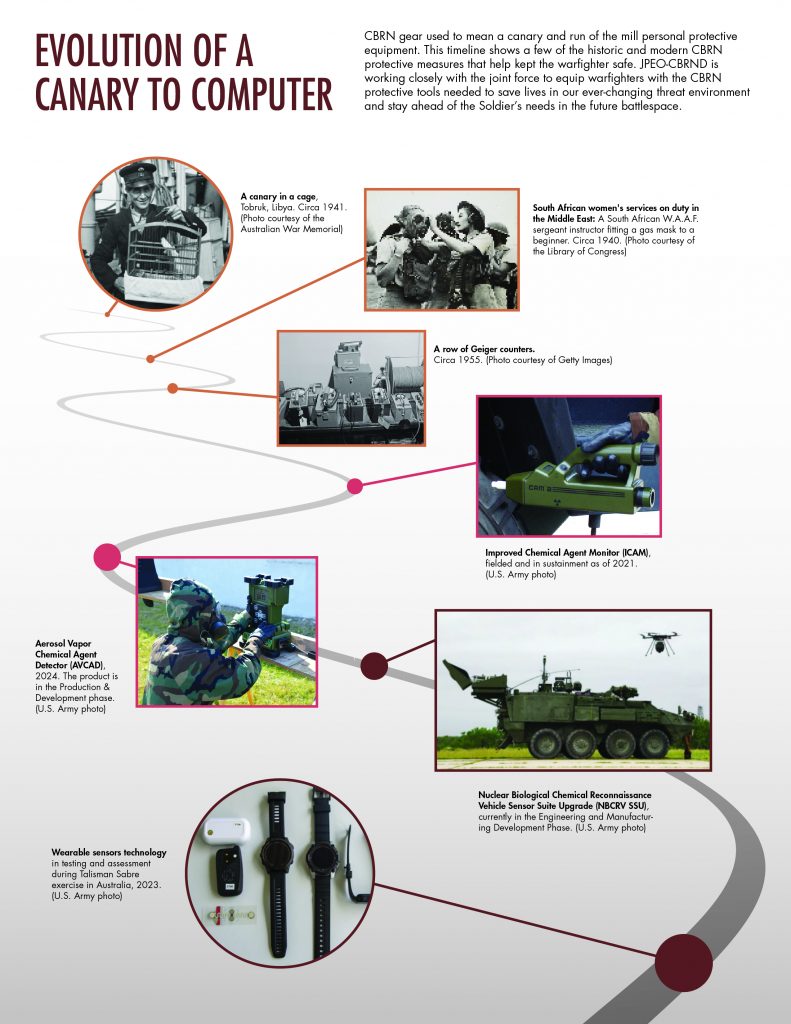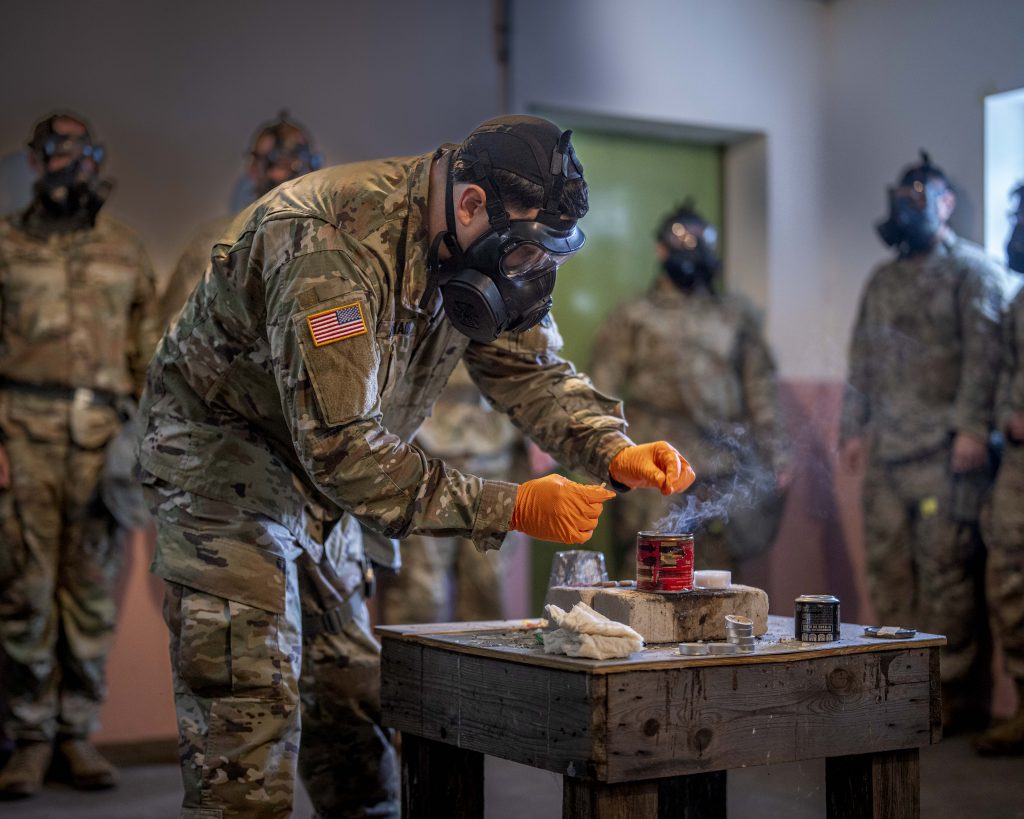
BASIC CBRN TRAINING: U.S. Army Spc. James Collins, 10th Army Air and Missile Defense Command, secures his mask during a comprehensive CBRN training held by Headquarters and Headquarters Battery on May 31, 2024, in Landstuhl, Germany. (Photo by Sgt. Yesenia Cadavid, 10th Army Air and Missile Defense Command)
Digital transformation and the modern CBRN battlespace.
by Vashelle Nino
Humankind has long sought innovative ways to circumvent threats to existence, oftentimes modifying established solutions to suit a prevailing need. An exemplar of this innovation can be found in the evolution of chemical, biological, radiological and nuclear (CBRN) defense from modest beginnings to the present digital battlespace.
Perhaps the earliest incarnation of modern day CBRN defense traces back to 19th century coal mines, the setting of a vital but life-threatening industry. The oxidation of coal produced carbon monoxide, a noxious and notoriously undetectable gas. This is how the high-flying, bright-feathered canary came to accompany coal miners deep into the mines. Their sensitivity to (and subsequent death from) poisonous gas alerted their human counterparts to an airborne threat long before they would feel its effects. Though a crude practice by today’s standards, miners came to see canaries as sentinels and protectors.
This primitive early-warning system was soon adopted by Soldiers during World War I, becoming one of our warfighters’ earliest attempts at CBRN detection and defense. Canaries became a highly valued asset on the battlefield—even appearing in war memoirs—and would go on to be used during the 1990’s Gulf War and by Iraqi civilians for potential chemical agent detection as recently as Operation Iraqi Freedom.
Still, canaries as CBRN detection devices had its drawbacks. For one, escape of a canary tipped off opposing forces nearby, compromising defense strategy. Also, many viewed use of these unsuspecting animals as an inhumane practice. But perhaps most crucial, it was a rudimentary solution traversing a landscape advancing toward the digital world and our rapidly changing modern battlespace.

WILL DO CSC2: Drew Murphy, joint product lead for CBRN Integrated Early Warning, demonstrates the CBRN support to CSC2 tool to leaders at Focus Falcon 2023 on Aberdeen Proving Ground, Maryland, in August 2023. (Photo by Matthew Gunther, JPEO-CBRND)
FLYING TOWARD DIGITIZATION
By the 1950s, CBRN detection capabilities had advanced significantly from the canary to more progressive devices. However, challenges such as lack of mobility, susceptibility to the elements and inability to provide warning to nearby warfighters ensured a short shelf-life for most detection prototypes; and while incremental improvements would be made, capabilities evolved into the digital domain at a relatively slow pace. Fortunately, this is not the case today.
The Joint Program Executive Office for Chemical, Biological, Radiological and Nuclear Defense (JPEO-CBRND) is adopting digital technologies to transform processes and improve the development of capabilities that serve the joint force to keep pace with the ever-changing threat environment, which is gaining speed and becoming more dynamic. The Joint Program Executive Officer for CBRN Defense Darryl Colvin has emphasized the importance of staying at the forefront of this work for the Army and the DOD’s Chemical and Biological Defense Program. Colvin shared his vision for the future of CBRN defense technology: “It is all about the data. We want the warfighter to have as much information as possible at their fingertips so they can understand the environment, make informed decisions and respond faster to the situation. This requires integrated systems communicating and working together to provide situational understanding, getting actionable information to the joint force faster.” The JPEO-CBRND is building on this vision and taking steps to integrate today’s CBRN defense equipment and its data into digital spaces to inform and improve command decision making.
The absence of information generates blind spots. This puts commanders at a disadvantage and warfighters’ lives at risk. The Army is harnessing the power of data, digital engineering, software and workforce development to integrate CBRN defense capabilities into the battlefield common operating picture across all the services.

TRANSFORMATION THROUGH DATA INTEGRATION
Digital transformation in the form of data integration increases readiness, preparedness and lethality on the battlefield, and thorough situational understanding requires systems and capabilities to communicate with each other, faster, in a networked system across the joint force. In short, we cannot afford to think of CBRN environments as separate, isolated battlespaces.
Recently developed technologies—such as the CBRN Support to Command and Control (CSC2)—enable situational awareness and command and control to continue operations in a CBRN-compromised or threatened environment. CSC2 integrates sensor data into a common architecture across the joint force, allowing for a near “plug-and-play” capability while providing automated CBRN hazard warning and reporting, which enables accelerated decision making and reduces false alarm rates. Paul Gietka, joint project lead for CBRN Integration said, “CSC2 enables the interoperability and integration of CBRN and non-CBRN sensors to achieve critical situational awareness and understanding, increasing the speed and confidence in which commanders can make informed decisions.”
Unlike the canary method, CSC2 does not stop at merely detecting and warning of the CBRN threat. It provides analysis, reporting and decision support that will help commanders quickly interpret and use available data, increasing confidence on the battlefield while protecting warfighters and keeping them in the fight.
CHAMPIONING DIGITAL LITERACY
To keep capabilities such as CSC2 relevant and effective, it is crucial for the CBRN defense community to stay abreast of developing technologies. To that end, JPEO-CBRND is leading the charge through a Digital Literacy Campaign, providing learning opportunities to its workforce so that practitioners can remain adaptable and capable of using and acquiring digital technologies within their capabilities development pipeline. In turn, the workforce will benefit from increased accessibility to digital products; enhanced virtual collaboration for continuity of operations; faster adoption and use of new digital technologies, processes and tools; and improved information sharing. This not only enables incremental—and thus, current—delivery of capabilities, but the capacity for those capabilities to be improved over time in the pursuit of agile design, development and delivery.

PUTTING IT TO THE TEST: U.S. Army Sgt. 1st Class Carlos Moranbonilla, 10th Army Air and Missile Defense Command, creates tear gas during a comprehensive CBRN training held by Headquarters and Headquarters Battery in Landstuhl, Germany on May 31, 2024. (Photo by Sgt. Yesenia Cadavid, 10th Army Air and Missile Defense Command)
IT TAKES A VILLAGE
While JPEO-CBRND is making strides to ensure the digital competency of its workforce, it is impossible for the organization to cover the depth and breadth of CBRN defense modernization digital transformation alone. JPEO-CBRND actively seeks industry and academic support in the areas of data integration and digital transformation. One main avenue JPEO-CBRND employs to connect with potential partners is through its Joint Enterprise Technology Tool, or JETT.
JETT is a web-based engagement tool designed for industry, academia and laboratories to introduce their ideas and capabilities to JPEO-CBRND so they can accurately and effectively connect them with the appropriate decision-makers within the organization. This might be an engineer with a product that could support portfolio integration, an artificial intelligence company with operational data science to support CBRN decision-making or a pharmaceutical developer who has a platform technology the JPEO-CBRND should know about no matter where they are in the development process. “We want to know what industry is pursuing and discover new ideas and technologies that could potentially help shape future capabilities for the joint force,” said Josh Israel, chief engineer and manager of the JETT program. “We are always looking to partner with those who want to make a difference and solve problems together.”
CONCLUSION
CBRN defense has evolved vastly from a lone canary in a coal mine. Thanks to modernization and digital transformation, our warfighters are better informed, prepared and protected from CBRN threats more than ever. But the quest to protect our service members using an effective integrated layered CBRN defense is far from over. Just as canaries came to be seen as esteemed protectors during their time, digital transformation and CBRN defense modernization efforts ensure that our valued protectors—our nation’s warfighters—have the capabilities they need to fight and win in CBRN contested environments on a rapidly evolving battlefield.
For more information, refer to the JPEO-CBRND’s Digital Transformation Smart Book.
If you’d like to see additional content on this subject, go to these links:
YouTube: https://youtu.be/XGKWsQI0d1E
DVIDS: https://www.dvidshub.net/video/940238/canary-computer-evolution-cbrn-defense-technology
VASHELLE NINO is a senior consultant at Booz Allen Hamilton, where she supports strategic communication projects in support of the U.S. Army. She holds a B.A. in English from Texas A&M University-Central Texas.







